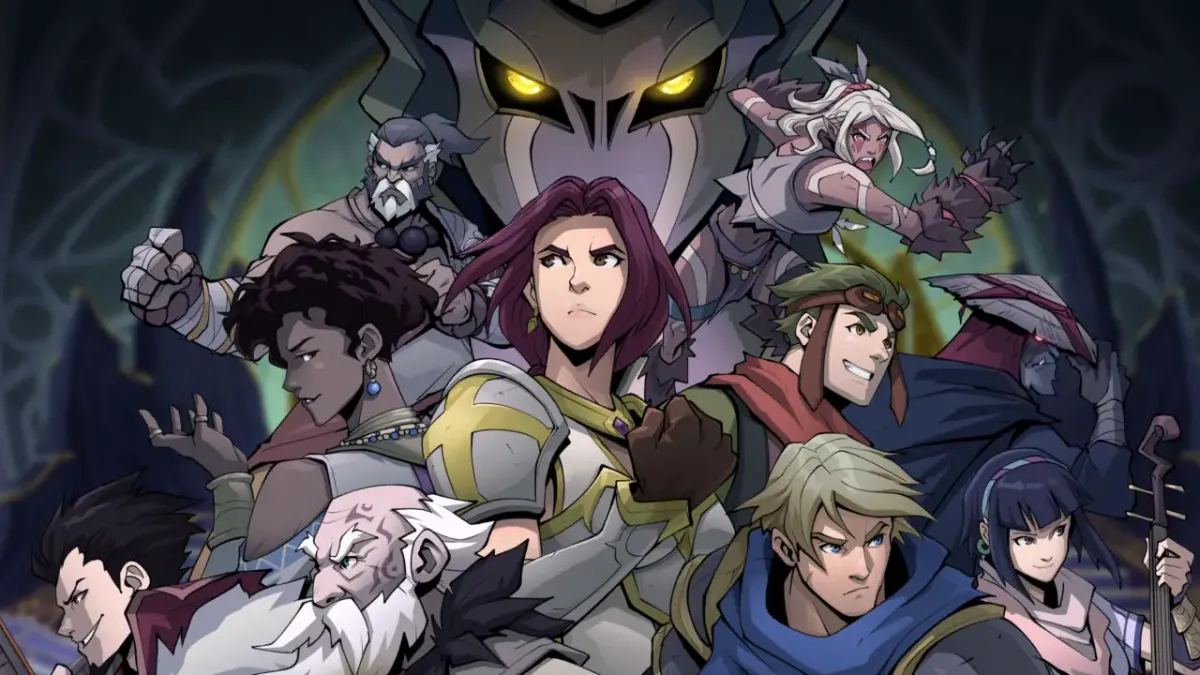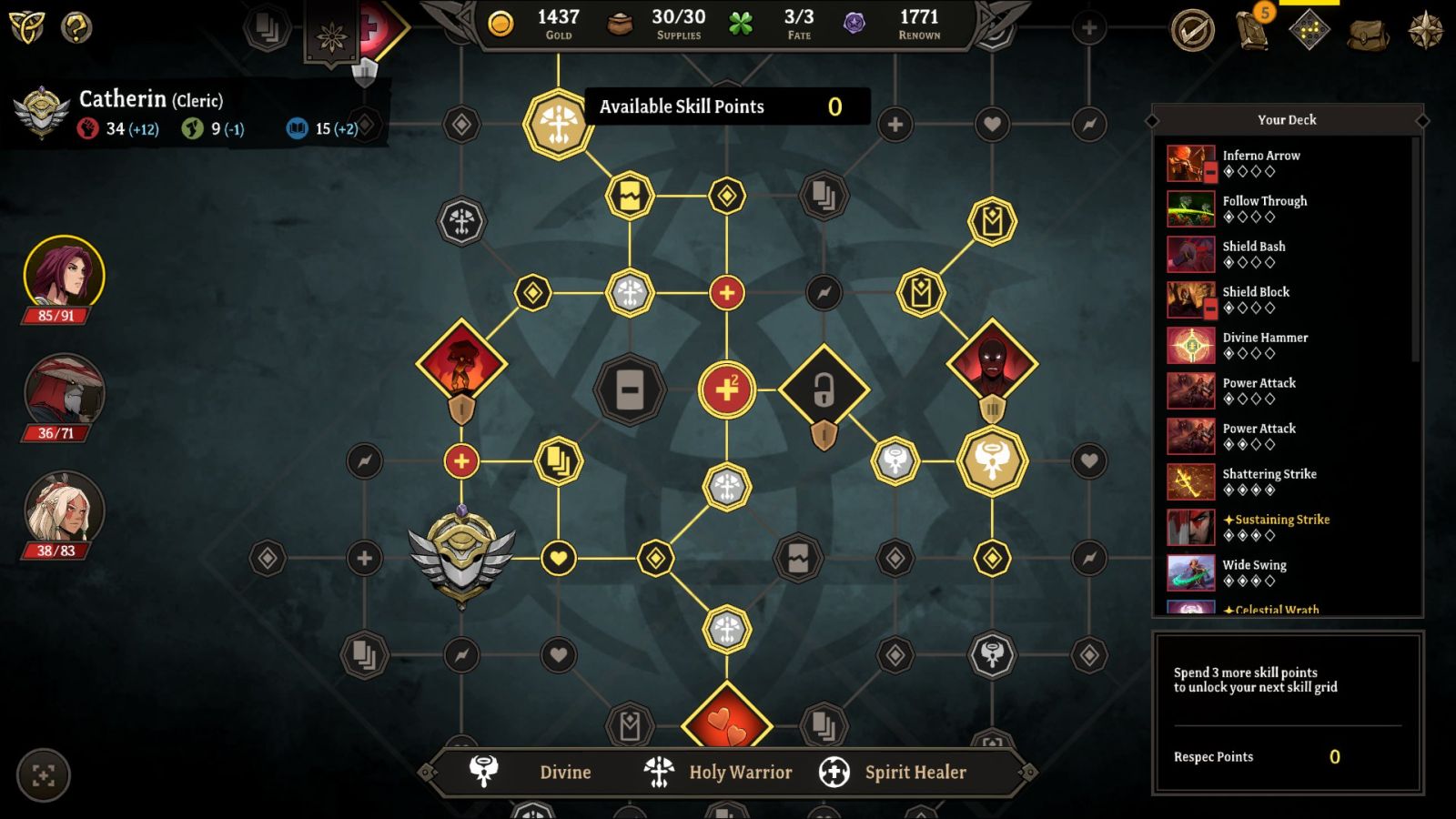
Gordian Quest opens as your team approaches the mountain city of Silverkeep. Meant to be a quick stop, you find yourself helping the local head of the military, Captain Rodrick, uncovering that the city is besieged by the undead. Big damned heroes, you decide to work with Roderick to uncover the source, and ultimately the true threat behind it.
At its core, Gordian Quest is a deck builder. With inspirations like Slay the Spire, Tainted Grail: Conquest, and Guild of Dungeoneering, your ever-expanding (you’ll end up with 10 by the end) group of adventurers will tackle progressively stronger foes across four enormous acts. These four acts will easily require 25 to 30 hours or more to complete the first time. I say “first time” as the 10 classes are all wildly different, practically demanding replay. The Swordhand, Cleric, Ranger, Scoundrel, Spellbinder, Druid, Bard, Warlock, Golemancer, and the Monk all require completely different tactics to master, and it’s very likely you’ll settle into just a handful that you enjoy playing, leaving a whole cadre of characters waiting for another run. How you build those classes is the core loop, the strength, and the weakness of Gordian Quest, all rolled into one.

Firing up the game you’ll be greeted with several options on how to start the game. The aforementioned campaign mode, a realm mode, and a skirmish mode. The campaign is self-explanatory, with an end-game mode that will allow you to continue through random dungeons and missions with your existing crew. Realm Mode is a shorter challenge mode that is roguelike in nature. Entitled Quick Run and Endless Run, you’ll either tackle just five levels or play infinitely until you are eventually defeated. The final mode is Skirmish, offering up a 1v1 PvP mode to square off against your friends.
One of the things I really enjoy about Gordian Quest is the synergies you can uncover. By fielding classes with skills and tactics that interconnect, you might unleash a bleed effect on a number of foes only to have another class exploit that weakness to unleash a massive and devastating attack. It’s still very much dependent on drawing the right cards at the right time, but that can be controlled to some degree with a carefully pruned deck.
Cycling through your cards to get the best ones is the best way to crush your foes. Slim it too much, however, and you might not have the right tools for the enemy ahead of you. There’s a minimum size for your overall deck, but for a while, it’s fine to let it run wild. This is where you’ll dig into the skill grid.
Leveling up you’ll receive a single point to spend on a grid. There are just a handful of choices, but after you put a few in you’ll be able to lay down another grid adjacent to the existing one. As each class has three specializations, and every grid is a different layout, you’ll have to be mindful of where you place it to make sure you can take advantage of it quickly. Each node offers a boon-like fury, additional hit points, a fresh crop of cards to convey skills, or a point you can sink into Strength, Intelligence, or Dexterity. Those three stats govern which weapons, armors, and accessories you can equip, so don’t ignore those.
Speaking of equipment, Gordian Quest has plenty of it. Using an MMO-like rarity system you’ll collect weapons, armors, hats, cloaks, gloves, boots, rings, belts, amulets, augments, and potions for each character. This equipment has a specific number of sockets of various colors, and with the right piece of gear, might even have a slot where you can attach a specific attack or defense card, or comes pre-populated with the same. The slots are most often color-coded so you can attach gems that improve the primary stats or grant additional attributes like poison, fury, focus, and more.
Speaking of stats, there are more than a few that don’t ultimately feel all that important, at least at the default difficulty level. Things like resistances and summon counts don’t impact the game at this level, and even things like exhaustion aren’t that much a challenge. More often than not, you can easily reach someone that can restore your cards fully, or you can camp to accomplish the same task. This does sap away some of the “you have to live with your choices” aspects of the game. It’s something that could be alleviated with a little post-launch polish, or tackling the game at higher difficulty levels I suspect.
With cards in hand, it’s time to jump into combat. Die 20s roll on the top of the screen as everyone, including your enemies, roll for initiative. With a move order determined, each character will draw cards from his or her deck. Those cards have an action point cost or AP. As your character levels up and spends points on the grid they can grow their pool of AP, but generally speaking, that’s your attack pool. A second bar, SP, builds up and is used for other attacks like spells and special moves. Once you’ve expended your AP, SP, your cards, or all of them, it’s time to end your turn. Play continues to the next person who rolled highest in the initiative check, and so on until both sides have finished their moves. At the end of the round, any specials or conditions that trigger at the end of a sequence will happen, closing out that round.

Throughout the map, you’ll find locations marked with question marks. These represent a choose-your-own-adventure or D&D style moment where you’ll be presented with choices to make tied to your skills and stats. Sometimes you’ll get an opportunity to recover some items or gold, pushing the player to choose a specific person to roll against their skills. Additionally, you might encounter a trap and your whole crew has to make a dexterity check to avoid taking serious damage. This is where exhaustion comes in.
Exhaustion is where you’ve effectively sacrificed a card from your deck to give you a bonus to your rolls. So, in the scenario above, you might have a wizard who can’t make a solid Dex roll, but by sacrificing a powerful card, they’ll gain +9 for that roll, almost guaranteeing success. These cards remain exhausted until you’ve gotten some proper rest, so choose wisely. You can also exhaust your cards by running out of supplies. Your food only lasts so long while roaming away from your home base, and each step costs additional supplies. There are ways to recover supplies in the field, but when it drops to zero, every step causes exhaustion, making additional cards unavailable until you’ve rested. Exhausted cards show up during any encounter you might have. This takes up valuable hand space, and they are useless in battle or for a skill check, so it’s important to minimize these.
The combat is obviously the focus with Gordian Quest, and it’s done well. Your team is positioned on a 3×4 grid with boss battles expanding that to a fourth lane. Casters are harder to reach when you put them in the back, and archers have additional damage opportunities from further away. Some skills will let you shift to another lane, using your precious SP instead of action points, but normally it’s going to cost you an action point to move. Careful formation planning is key to later battles and is absolutely crucial to boss fights where your less armored heroes will fall quickly otherwise.
About halfway through the second act, you’ll hit the true Gordian knot in Gordian Quest. All momentum in the story comes to a halt when you come face to face with foes that are a huge leap over your level and equipment, meaning you’ll need to get out there and grind. Since equipment and foes are randomized, it’s a dice roll on how fast or slow you hit the readiness to take on a boss that is double your level and has an order of magnitude more health. Even at level 31, I found myself awash in vendor trash. You can use various implements to upgrade said gear from mundane to magical, but it always feels so random that it’s as reliable as the drops. I found myself holding out for legendary drops instead of trying to force them with the upgrade mechanics.
The other bugbear in Gordian Quest is something the team is hoping to have resolved for launch, or closely following – tutorialization. There are a few aspects of the game that you’ll intuit through use, but even after 30 hours, I don’t know what the “expend” aspect is, or why I can’t seem to target my people or the enemy with some cards. There are keyword mouse-overs on nearly everything of importance, but the few that are missing might leave you with dead cards in your hand until you suss out their purpose.
Once you’ve done a bit of adventuring, it’ll be time to rest. Using a system, not unlike Darkest Dungeon, you’ll set up camp for a number of hours and be presented with several activities. You can build up a specific card, but that’ll cost several hours, whereas foraging for additional supplies will only cost one. Each character also has a trio of skills that might yield ongoing boons, heal themselves, or even heal the party, just to name a few.
There are a lot of interwoven systems in Gordian Quest, and it only takes a short while to understand how they all flow together, often one feeding the other. These systems are steadily rolled out and introduced as you move between acts, so as to not overwhelm the player. There is a little bit of randomness and chance to all of it, but a little grinding and luck can yield the results you are looking for. Whether it’s rolling for new slots on your equipment, or for a mystery upgrade from vendor trash to magic, adds more to the RPG side of the equation, and is a welcome one.
Unfortunately, there is one hiccup that I hope will be short-lived – stability. I’ve had multiple lockups during the Explore quest types where the controls go completely dead and I’m unable to interact or quit, forcing me to use task manager to kill the game. Thankfully the game autosaves constantly, so you won’t lose any progress, but that instability is frustrating.
Developer Mixed Realms has put a lot of time and effort into the game’s look and sound. The game is a card battler, with a semi-papercraft look about it, but the characters in your party are anything but. Each of your ten characters are given the royal treatment, with hand-drawn and beautiful anime-style artwork. Each foe gets similar treatment, but just a headshot to represent them in battle. Truthfully, it’s the sort of AAA artwork I’d expect out of a far larger house with dozens of artists. Similarly, the music and sound effects are hard-hitting, and even after 30 hours, I can’t say I’ve grown tired of them. The art and music in this game are absolutely top-notch.
Ultimately, Gordian Quest is a game that feels like an RPG with Deckbuilder elements instead of the other way around.
Gordian Quest
Great
Summary: If you are a fan of deckbuilding card battlers, with a dash of RPG, then Gordian Quest is the best of the bunch. While there are a few tutorial elements and stability challenges to attend to, the endless replayability and randomization element makes every run unique.
Pros
- Gorgeous visuals and soundtrack
- Combat synergies are engaging and fun
- Endless replayability
- All ten characters are unique and challenging
- Decision moments are a highlight
Cons
- Game stability is a problem at launch
- Some terms and mechanics need further explanation
- Stats can be somewhat pointless at lower levels
